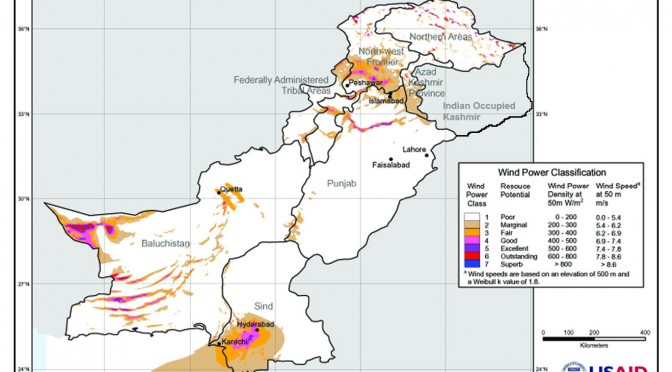The Alternate Energy Development Board (AEDB) has embarked on an ambitious plan to enhance the energy mix up to 20 to 25 percent by adding 3,000 to 3,500 megawatts wind power based electricity to the national grid system by 2018.
Out of this as many as 1,396 megawatt wind electricity will include in the system by 2017 as the AEDB would complete several projects initiated for alternate power generation, Chief Executive Officer (CEO) Amjad A Awan said in an interview with APP.
Awan said currently the wind projects having 255.4 megawatts power generation capacity are operational across the country, including FFC Energy (49.5 MW), Jhimpir Zorlu Enerji Pakistan (56.4 MW), Jhimpir Three Gorges First Wind Farm Pakistan (49.5 MW), Jhimpir Foundation Wind Energy-II (50 MW) Gharo and Foundation Wind Energy I (50 MW) Gharo.
Awan said 28 ongoing wind projects of 1,396.4 MW capacity would be completed by 2017, which would play a major role in overcoming the energy crisis on which the government is focusing.
He said out of these nine projects (477 MW) have achieved financial close and are under construction.
These projects include Sapphire Wind Power Company (50 MW), Yunus Energy (50 MW), Metro Power Company (50 MW), Jhimpir Tapal Wind Energy (30 MW), Jhimpir Gul Wind Energy (50 MW), Jhimpir United Energy Pakistan (99 MW), Jhimpir Hydro China Dawood Power (50 MW) Gharo, Master Wind Energy (50 MW), Jhimpir and Tenaga Generasi (50 MW) Gharo. Fourteen wind power projects with a cumulative capacity of 664 MW are at different stages of project development and are expected to be completed by 2017/18.
He said there has been strategies that favour that one percent of energy should come through alternate sector; however we aim to rise it up to 20 to 25 percent by 2018.
He said power tariff for wind power projects has been reduced to 10.4 cents, which indicates that this could prove a promising sector for future investments.
He was of the view that Pakistan was having huge wind power generation potential and if exploited properly it could become a very lucrative and feasible source of alternate energy.
Pakistan naturally is gifted in alternate energy resources and this has been identified by mapping assessment of wind solar and biomass in the country through ESMAP’s (World Bank) assistance.
He said although the wind potential has been evaluated at a huge scale; however as far as our studies and surveys are concerned “we have specifically identified the wind corridors having power generation potential of 30,000 megawatts.”
He said the AEDB has identified the high potential regions, including in Southern Sindh Balochistan and Punjab where electricity generation through wind has a promising potential.
Awan said some of the wind potential areas have also solar intensity so in such regions both wind and solar energy could be generated simultaneously and this may also be very attractive for the investors.
He said there has been good responses from the investors to invest in this particular field of energy generation and observed that when the investors are given confidence over the sustainability of the projects they willingly come to invest.
The CEO said historically Pakistan has been leading energy sector in the region as it has been pioneering to produce through various sources, including coal, gas, bio gas, wind and solar.
“We were the first to set up regulatory authority and initiated power generation through independent power producers,” he said.



